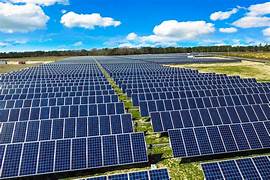Solar Inverters
A solar inverter, or PV inverter, converts the variable direct current (DC) output of a photovoltaic (PV) solar panel into a utility frequency alternating current (AC) that can be fed into a commercial electrical grid or used by a local, off-grid electrical network. It is a critical component in a photovoltaic system, allowing the use of ordinary commercial appliances. Solar inverters have special functions adapted for use with photovoltaic arrays, including maximum power point tracking and anti-islanding protection.
Solar inverters are components that are commonly found in photovoltaic (PV) power systems. The purpose of a solar inverter is to transform direct current (DC) generated by a PV system into alternating current (AC), which can be sent into a power grid or consumed on site. These inverters can be used either in concert with battery systems or to directly power certain devices.The process of altering DC into AC is performed by an inverter, though most of these devices are designed to work with non-variable direct current. Unlike most other inverters, a solar inverter is designed specifically to work with the variable DC generated by PV arrays.
Solar System have these component which is work for generated for power
Pannel
 A solar panel (photovoltaic module or photovoltaic panel) is a packaged, interconnected assembly of solar cells, also known as photovoltaic cells. Because a single solar panel can produce only a limited amount of power, many installations contain several panels. A photovoltaic system typically includes an array of solar panels, an inverter, and sometimes a battery and interconnection wiring.
A solar panel (photovoltaic module or photovoltaic panel) is a packaged, interconnected assembly of solar cells, also known as photovoltaic cells. Because a single solar panel can produce only a limited amount of power, many installations contain several panels. A photovoltaic system typically includes an array of solar panels, an inverter, and sometimes a battery and interconnection wiring.
Racking.
 This appliance used to secure the panels onto the roof.
This appliance used to secure the panels onto the roof.
Solar Array
The solar array consists of one or more PV modules which convert sunlight into electric energy. The modules are connected in series and/or parallel to provide the voltage and current levels to meet your needs. The array is usually mounted on a metal structure and tilted to face the sun.
Solar charge controller
A charge controller may be used to power DC equipment with solar panels. The charge controller provides a regulated DC output and stores excess energy in a battery as well as monitoring the battery voltage to prevent under/over charging. More expensive units will also perform maximum power point tracking. An inverter can be connected to the output of a charge controller to drive AC loads.
Battery Bank
The battery bank contains one or more deep-cycle batteries, connected in series and/or parallel depending on the voltage and current capacity needed. The batteries store the power produced by the solar array and discharge it when required.
Inverter
 An inverter is required when you want to power AC devices. The inverter converts the DC power from the solar array/batteries into AC power.
An inverter is required when you want to power AC devices. The inverter converts the DC power from the solar array/batteries into AC power.
Solar Inverter types
1. Microinverters
Can also be called “module” inverters. Microinverters are often used to convert direct current produced by many renewable energy sources like solar panels or small wind turbines, into the alternating current (AC).
It runs by pulling direct current power from batteries charged by other resources like engine generators, hydro turbines and wind turbines.
Stand-alone inverters refill the battery coming from an alternating current source whenever possible.
It is used in homes and in small industrial buildings as a power backup.
A 10 kilowatt inverter could be used to independently manage the power to a house or small business firm.
For a regular homeowner with small appliances, the stand alone solar inverter could be the perfect option, though the inverter generates only limited energy.
2. String inverter(grid tie inverters)
Grid tie inverters are programmed to automatically turn off during power losses to ensure safety. Hence it saves the value of the product and its durability.
The Grid Tie Inverters allows the homeowner to work with a power company. The electricity is collected through panels and will be stored to the batteries for further consumption.
Once the energy is not in use, you can decide to sell it to the power company, which prevents you from wasting the energy.
3. The Battery Backup Inverters
The battery backup inverters are developed to get energy from batteries.It also manages the energy charge it gets from the battery through the onboard charger.It brings the extra energy to the utility grid.
They supply alternating current power to selected areas which will need energy during a power outage.The battery backup inverters are also required to be installed with an anti-islanding protection.
The Battery Backup Inverters are appropriate for commercial establishments. It is a great advantage to have such panels since they can save more money rather than renting generators and paying for the gas.
Stepwise explain how solar inverter works
(1) Solar Electric or PV modules convert sunlight to electricity. The PV modules generate DC electricity – or direct current – sending it to the inverter.
(2) The inverter transforms the DC power into AC electricity for ordinary household needs.
(3) Existing electrical panel distributes solar electricity and utility power to
(4) loads (appliances). For systems with a battery backup (optional), the inverter also regulates the charge of batteries. The electricity stored in the batteries can be used at night or during blackouts.
Utility Intertie PV Systems (Grid-Connected)
Intertie systems use an inverter that converts the energy collected from the PV panels into conventional AC power and feeds it to your electrical circuit breaker panel. As long as there is enough electricity flowing in from your PV system, no electricity will flow in from the utility company. If your system is generating more power than you are using, the excess will flow back into the grid, turning your meter backwards.


